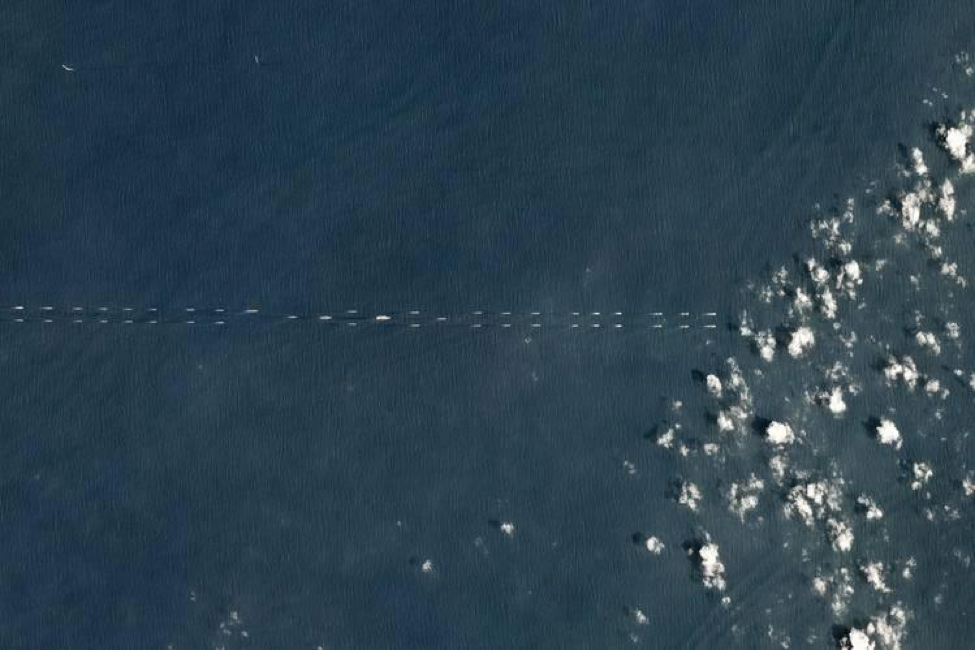Water Wars: Tensions Build as the South China Sea Hosts Military Exercises
Tensions Build as the South China Sea Hosts Military Exercises
The high tempo of Chinese military drills and operations in the South China Sea during recent weeks coincides with new deployments from the United States, illustrating the high stakes of territorial disputes in the region.

Published by The Lawfare Institute
in Cooperation With

Tensions Build as the South China Sea Hosts Military Exercises
The high tempo of Chinese military drills and operations in the South China Sea during recent weeks coincides with new deployments from the United States, illustrating the high stakes of territorial disputes in the region.
In its largest show of naval forces in modern times, the Chinese navy conducted a series of live-fire drills and formation maneuvers between March 24 and April 11. Satellite imagery confirmed that at least 40 vessels participated in the drills, including Liaoning, the first Chinese aircraft carrier. China’s military has been steadily building its capacity for joint operations of air, ground, and sea power as part of a modernization effort, and the exercises seem to be testing inter-fleet interoperability. The timing of the drills may have been influenced by recent deployments of foreign naval assets, although China considers its military operations “a routine annual planned arrangement for the navy.”
Following the naval exercises, the navy conducted a review attended by Chinese President Xi Jinping. The review is the largest since 1949 and involved 48 naval vessels (including the aircraft carrier), 76 aircraft, and over 10,000 troops. More than half of the participating ships were commissioned after 2012. After viewing the exercises, Xi pledged to accelerate China’s naval modernization and development. Following the review, China also held additional live-fire exercises in the Taiwan Strait on April 18—the first since 2015.
Other Chinese armed services have also conducted patrols recently. In late March, China’s air force held a series of drills over the South China Sea and the Miyako Strait, located between two Japanese islands.
The flurry of activity comes amid reports that China has recently installed radar- and communication-jamming equipment on the Spratly islands. The installations offer China the ability to hinder foreign military operations and may enhance China’s control over the area. China has also continued building out its military assets in the Paracel islands to the north. After quietly developing its capabilities over the past few years, China recently acknowledged that it has a “natural right as a sovereign nation” to militarize the islands.
American aircraft carriers regularly patrol the South China Sea in accordance with international maritime law, and the U.S. Navy has displayed its military might in the region with its recent deployments. On April 10, the USS Theodore Roosevelt conducted aircraft operations as it traversed the South China Sea on its way to Manila. The carrier hosted a group of Philippine officials and journalists to tour the vessel; Philippine Army Lt. Gen. Rolando Bautista noted that the U.S. military can “help us to deter any threat” against Philippine interests. The ship joined ships from the Singaporean Navy to sail in formation.
The heightened military activity comes shortly after another U.S. freedom of navigation operation. On March 23, the USS Mustin, an Arleigh Burke-class guided missile destroyer, sailed within 12 nautical miles of Mischief Reef. Because the destroyer conducted maneuvers, its operations were outside of the regime of innocent passage under the United Nations Convention on the Law of the Sea—making the demonstration a more direct challenge to the reef’s contribution to maritime zones. The reef itself was found to be a low-tide elevation in the South China Sea arbitration case in 2016 and accordingly does not generate a territorial sea under international law. This was the second U.S. FONOP this year, following the January transit near Scarborough Shoal.
China quickly condemned the FONOP: Foreign Ministry Spokesperson Hua Chunying accused the United States of having “violated the Chinese law and relevant international law” and “put[ting] in jeopardy the facilities and personnel on the Chinese islands.”
In Other News ...
In Vanuatu
The Sydney Morning Herald reported on April 9 that China has proposed building a permanent military base in the South Pacific islands of Vanuatu, approximately 1,200 miles northeast of Australia. Such a base would allow China to project naval power throughout the region and potentially upset the strategic balance of power. This would be China’s second overseas military base: The country opened its first such base in August 2017 in Djibouti.
The Chinese government has invested heavily in development and aid projects for numerous Pacific island-nations, including over $200 million in loans and grants to Vanuatu. The most significant project in that country has been the Luganville International Wharf on the island of Espiritu Santo, which is large enough to accommodate two freighters or one cruise ship. The United States recently conducted an inspection of the Luganville wharf to determine whether it could be used to dock U.S. warships in preparation for military exercises in the region.
The Sydney Morning Herald’s report set off a flurry of responses from Australia, China and Vanuatu. Australian Prime Minister Malcolm Turnbull stated that Australia would “view with great concern” the establishment of a Chinese base, and Australian military officials have confirmed their belief that China has been pursuing a base on the islands.
Vanuatu itself has denied the reports, with the country’s foreign minister, Ralph Regenvanu, telling the Australian Broadcasting Corporation, “We are not interested in militarisation, we are just not interested in any sort of military base in our country.”
When asked about the report that China was interested in building a military base in Vanuatu, Chinese Foreign Ministry Spokesperson Geng Shuang dismissed the report as “fake news,” citing Minister Regenvanu’s denial.
In Vietnam
Bowing to pressure from China, Vietnam suspended an oil drilling project in the “Red Emperor” zone off its southeastern coast, near the so-called “nine-dash line” that demarcates China’s territorial claim. In suspending the project, Vietnam has forced the Spanish energy firm Repsol to halt operations just as it was making final preparations for commercial drilling, potentially endangering a $200 million investment. This is the second energy-exploitation project Vietnam has suspended in the past year due to Chinese pressure.
China and Vietnam have also been engaging in high-level talks to resolve their dispute over the South China Sea, where both claim overlapping territory. On April 1, Chinese Foreign Minister Wang Yi and Vietnamese Foreign Minister and Deputy Prime Minister Pham Binh Minh met in Hanoi, after which Yi told reporters, “We have agreed that settling the maritime issues is extremely important for the healthy and sustainable development of bilateral relations.” The two countries had announced in November that they would attempt to resolve their dispute through diplomacy.
Vietnam has worked to strengthen its ties to India, Japan, Australia and the United States in recent years as China has become more aggressive in exerting its influence. Vietnam hosted a U.S. aircraft carrier, the USS Carl Vinson, in March.
In Japan
One of the most notable of the military exercises occuring in the past month was Japan’s activation of its first amphibious brigade since World War II, which took place on April 7 at the city of Sasebo in Nagasaki prefecture. The Amphibious Rapid Deployment Brigade, which currently has 2,100 members, will eventually boast 17 V-22 Osprey tilt-rotor aircrafts and 52 amphibious assault vehicles; it is charged with taking or retaking contested islands in the event of an invasion.
The activation of the brigade occurs in the context of rising tension with China over the Senkauku Islands, where China has become increasingly bold in patrolling through Japanese-controlled waters. The lack of effective amphibious units in the Japanese Self-Defense Force also hindered rescue efforts following the 2011 Tohoku earthquake.
Japan has been gradually building its military power over the last 10 years despite its pacifist Constitution, which was put in place in reaction to its expansionist World War-II era history. Prime Minister Shinzo Abe has proposed changes to the Constitution to allow for a more active approach to self-defense, changes that the Chinese government has strongly opposed.
The U.S. Marine Corps worked closely with the Japanese Self-Defense Force in helping develop its doctrine and training and also participated in the April 9 military exercise marking the brigade’s activation. Joining the Japanese forces for those exercises was a U.S. amphibious assault ship, the USS Wasp, which carries the Navy’s new F-35B Lighting II Joint Strike Fighter, and its accompanying strike group.
Japan is not alone in building an amphibious force. Both India and Australia have been developing marine infantry units in recent years by training troops and buying transport crafts. The Chinese navy has also been working to develop is amphibious capabilities: It recently unveiled a new 29,000-ton, 210-meter “Type 071” landing craft, following the announcement in 2017 that it plans to increase the number of its marine infantry from 20,000 to 100,000.
Analysis and Commentary
In the Sydney Morning Herald, Peter Hartcher warns that the construction of a Chinese military base in Vanuatu would place Australia in “check,” due to the lack of natural barriers between the islands and the Australian coast.
Writing at the Brookings Institution, Lynn Kuok argues that China should look to the Soviet example as it develops its naval capabilities and its approach to the international law of the sea. As China’s blue-water navy grows, international freedom of navigation will become more important to Chinese operations. The country will become more dependent on the high seas freedoms that it has challenged in the South China Sea.
In The Diplomat, Ankit Panda suggests that more assertive action from Washington could have prevented Vietnam’s abandonment of energy projects in the South China Sea. Despite the increase in military attention to the region, such as through the freedom-of-navigation program, the United States and others have not voiced support for Vietnam’s claims as China has threatened the country.
In the South China Morning Post, Frank Tang and Sarah Zheng interview experts about China’s recently announced Hainan Plan, which creates a free-trade zone in the island of Hainan. Tang and Zheng conclude that the plan aims to counterbalance American maneuvering by increasing China’s economic ties to other countries in the region.
And for War on the Rocks, Lyle Morris analyzes the Chinese government’s decision to transfer administrative control of its Coast Guard from civilian to military control. These changes are important, he notes, because they will allow a mission more focused on law enforcement and combat, along with increased coordination between China’s Coast Guard and Navy.






